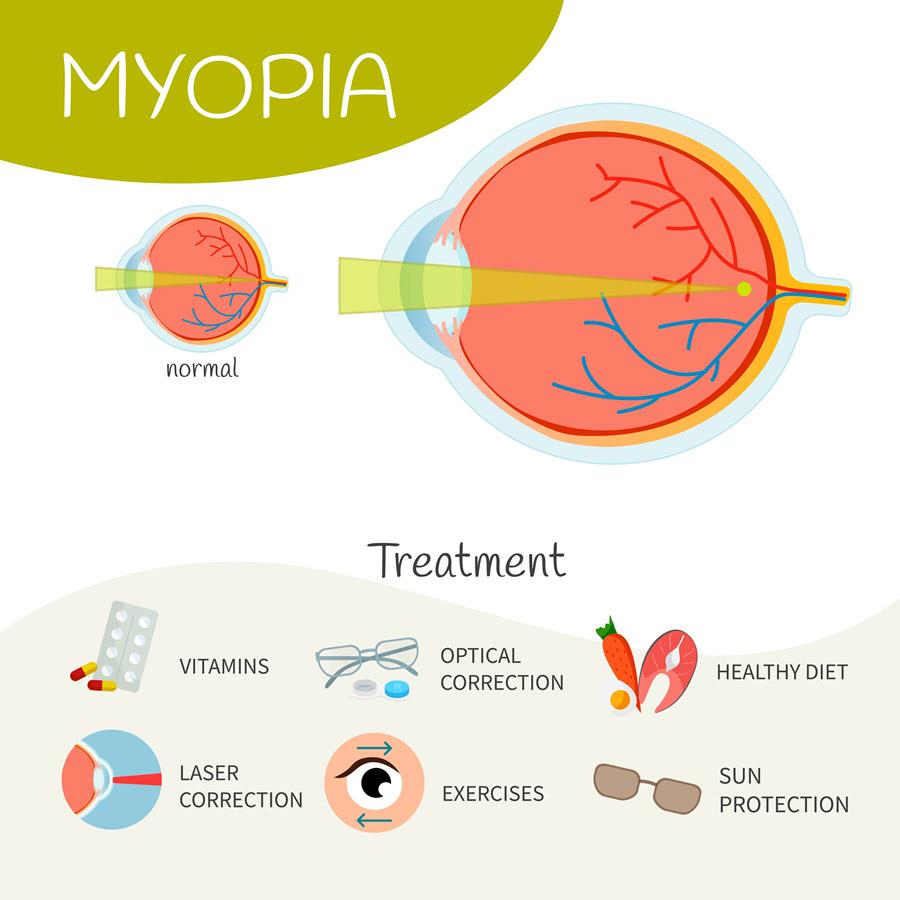Introduction
Myopia refers to a condition which makes distant objects appear blurred. People with myopia can clearly see objects near them. Objects such as content on books, mobile phones and laptops. However, they may have difficulty watching TV or seeing the whiteboard in a classroom. Myopic persons may experience headaches and eyestrain because of struggling to see distant objects.
It typically develops from the age of 6 and will gradually progress until age 20. Myopia is common with East Asians and less common in Africans or African Americans. It is also more common with urban dwellers as opposed to people living in rural areas.
Sub-Types
- Non-pathologic (physiological, simple, or school)
Refractive structures develop normally but the refractive power of the eye does not correlate with the axial length.
- Pathologic (high) myopia
Refractive errors begins at early childhood and progress.
Causes and Risk Factors
Myopia occurs when the eye grows too long from front to back. The lens of the eye ends up focusing in front, instead of on the retina. It’s not quite clear what causes myopia. But research points to genetics so that children born to one or more myopic parents are more likely to develop it.
A thick lens on the cornea may be another cause of myopia. The cornea may also be too curved for the length of the eyeball.
It may also be influenced by situations such as working long hours on a computer/screen or staying indoors. Children who play outdoors are at a lesser risk of developing myopia. But once it develops, time spent outdoors will not necessarily slow down myopia progression.
Although myopia is common in children, adults are also at a risk due to stress on the eye occasioned by near work. Near work refers to activities done at short working distances such as reading, doing homework, playing video games and so on. Sometimes it is related to other health issues like diabetes.
High myopia can increase risks of retinal detachment, cataract, and glaucoma. All these three conditions are serious enough to cause visual loss.
Signs & Symptoms
Signs and symptoms that indicate possible myopia include:
- Blurred distance vision
- Squinting while viewing distant objects
- Nearness to the TV or whiteboard and so on.
- Decreased distance vision (which is the most popular symptom)
Here, patients with pathologic myopia could have their vision distorted.
Diagnosis
An eye care professional will diagnose myopia by examining the eye comprehensively. The eye care professional determines the extent to which the eyes focus light. The professional also determines the power required in optical lenses to correct the anomaly. A patient will identify letters written on a distant chart to determine visual acuity. He/she may use dilating eye drops for more complex cases.
Treatment
Treatment is directed towards improving vision in the myopic eye by diverting light rays that enter the eye so that they focus on the retina.
Medical Treatment
Eyeglasses or contact lenses will treat myopia. Their job is to refocus the light on the retina. Patients under 40 will have single-vision lens prescribed. Patients aged 40 and above will make do with the multifocal lens. However, lens can cause complications such as the distortion of the cornea and dry eyes. Hence, a doctor can use a phoropter to identify the best lens for a patient.
Orthokeratology can also be used to treat myopia. Here, patients wear a series of rigid contact lenses. The lens will apply pressure on the cornea thus reshaping it. They are worn over limited periods of time, for example overnight.
A retinoscopy can be conducted on young children to determine the best treatment.
Surgical Treatment
Once the eye’s optic error stabilizes, usually at age 20, a doctor can recommend refractive surgery e.g. Laser in situ Keratomileusis (LASIK) and Photorefractive Keratectomy (PRK) among others. LASIK reshapes the cornea to better focus light on the retina. The surgical procedure will see a small amount of tissue removed (a thin layer for PRK and the inner layers for LASIK).
Phakic Intraocular Lenses (IOLs) can benefit people whose corneas are too thin for laser surgery or have very nearsightedness. The lenses are surgically fixed inside the eye to help focus light onto the retina.
Home Care
Extra care needs to be taken with patients who have undergone PRK. This is due to the removal of the corneal surface cells before refractive surgery. The eyes will require long periods of healing. The surface cells need to grow again to regain the corneal surface.
Those who use contact lenses need to be very careful because they are worn directly on the eye.
Alternative Treatment
If muscle spasm is the cause of myopia, vision therapy is recommended where some eye exercises are done to improve vision.
Prognosis/Long-term outlook
Patients who develop the disease early have a worse prognosis for long term visual acuity. Myopia tends to progress more with longer axial lengths in such patients. These patients have a higher risk of developing myopic retinal degeneration.
A nearsighted person who corrects the condition using refractive surgery will be able to see far. However, he or she will start using reading glasses.
Prevention/Follow Up
There aren’t any guidelines presently to prevent myopia. Patients who expose themselves to near work are at a higher risk of getting myopia. Since myopia commonly develops in children, they should be encouraged to stay outdoors as much as possible. They should also reduce on near work.


